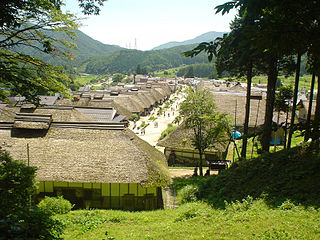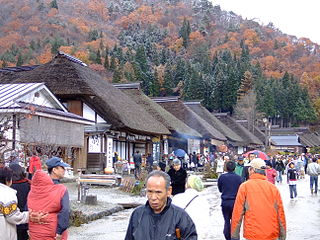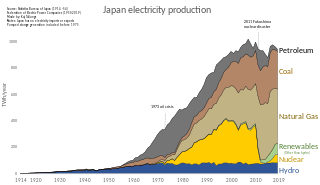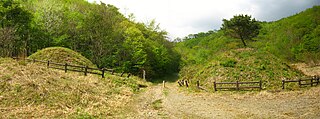
Hydropower, also known as water power, is the use of falling or fast-running water to produce electricity or to power machines. This is achieved by converting the gravitational potential or kinetic energy of a water source to produce power. Hydropower is a method of sustainable energy production. Hydropower is now used principally for hydroelectric power generation, and is also applied as one half of an energy storage system known as pumped-storage hydroelectricity.

Hydroelectricity, or hydroelectric power, is electricity generated from hydropower. Hydropower supplies one sixth of the world's electricity, almost 4,500 TWh in 2020, which is more than all other renewable sources combined and also more than nuclear power. Hydropower can provide large amounts of low-carbon electricity on demand, making it a key element for creating secure and clean electricity supply systems. A hydroelectric power station that has a dam and reservoir is a flexible source, since the amount of electricity produced can be increased or decreased in seconds or minutes in response to varying electricity demand. Once a hydroelectric complex is constructed, it produces no direct waste, and almost always emits considerably less greenhouse gas than fossil fuel-powered energy plants. However, when constructed in lowland rainforest areas, where part of the forest is inundated, substantial amounts of greenhouse gases may be emitted.

Shimogō is a town located in Fukushima Prefecture, Japan. As of 1 April 2020, the town had an estimated population of 5,517 in 2216 households and a population density of 17 persons per km2. The total area of the town was 317.04 square kilometres (122.41 sq mi).

Ōuchi-juku was a small post station in Japan's Edo period and part of the Aizu Nishi Kaidō. It is now located in the town of Shimogō in Minamiaizu District, Fukushima Prefecture, and is famous for the numerous traditional thatched buildings from the Edo Period that line its main street.

The Tokaimura nuclear accidents refer to two nuclear related incidents near the village of Tōkai, Ibaraki Prefecture, Japan. The first accident occurred on 11 March 1997, producing an explosion after an experimental batch of solidified nuclear waste caught fire at the Power Reactor and Nuclear Fuel Development Corporation (PNC) radioactive waste bituminisation facility. Over twenty people were exposed to radiation.

Taki Dam (滝ダム) is a gravity dam on the Tadami River, 7.3 km (5 mi) east of Tadami in Fukushima Prefecture, Japan. Surveys for the dam were carried out in 1958, construction began in 1959 and the dam was complete in 1961. The primary purpose of the dam is hydroelectric power generation and it supports a 92 MW power station consisting of 2 x 46 MW Kaplan turbines. The dam is 46 m (151 ft) tall and 264 m (866 ft) long. It creates a reservoir with a 27,000,000 m3 (21,889 acre⋅ft) capacity, of which 10,300,000 m3 (8,350 acre⋅ft) is active for power generation. The dam's spillway is controlled by four sluice gates and has a 200 m3/s (7,063 cu ft/s) discharge capacity.

Tagokura Dam (田子倉ダム) is a gravity dam, on the Tadami River in the Fukushima Prefecture of Japan. It is owned and operated by the Electric Power Development Company (J-Power). The lake which it impounds is known as Lake Tagokura.

The electric power industry in Japan covers the generation, transmission, distribution, and sale of electric energy in Japan. Japan consumed approximately 918 terawatt-hours (TWh) of electricity in 2014. Before the 2011 Fukushima Daiichi nuclear disaster, about a quarter of electricity in the country was generated by nuclear power. In the following years, most nuclear power plants have been on hold, being replaced mostly by coal and natural gas. Solar power is a growing source of electricity, and Japan has the third largest solar installed capacity with about 50 GW as of 2017. Japan's electricity production is characterized by a diverse energy mix, including nuclear, fossil fuels, renewable energy, and hydroelectric power.

Masushi Ōuchi was a Japanese weightlifter who won a bronze medal at the 1964 Summer Olympics and a silver medal at the 1968 Summer Olympics. He won two gold medals at the Asian Games in 1966 and 1970. He further became the world champion in the light-heavyweight category in 1969. In 1965–1969 Ouchi set eight world records – six in the snatch and two in the total. Later in life, Ouchi won four world titles in the masters category.

The Okutadami Dam (奥只見ダム) is a concrete gravity dam on the Tadami River, 26 km (16 mi) east of Uonuma on the border of Niigata and Fukushima Prefectures, Japan. The primary purpose of the dam is hydroelectric power generation and it supports a 560 MW power station which is the largest conventional hydroelectric power station in Japan. The dam also forms the second largest reservoir in Japan, next to that of the Tokuyama Dam.

The Otori Dam is a concrete arch-gravity dam on the Tadami River, 17 km (11 mi) southwest of Tadami in Fukushima Prefecture, Japan. The primary purpose of the dam is hydroelectric power generation and it supports a 182 MW power station. The power station contains two Kaplan turbine-generators. Unit 1 was commissioned on 20 November 1963 while Unit 2 was commissioned on 7 June 2003 as part of a power plant expansion project that included an additional 200 MW generator at Okutadami Dam upstream. The dam is 83 m (272 ft) tall and 188 m (617 ft) long. Its reservoir has a 15,800,000 m3 (12,809 acre⋅ft) capacity of which 5,000,000 m3 (4,054 acre⋅ft) is active for power generation. The reservoir has a catchment area of 656.9 km2 (254 sq mi) and surface area of 89 ha. Of the two generators, Unit 1 has a maximum effective hydraulic head of 50.8 m (167 ft) and Unit 2 is afforded 48.1 m (158 ft). The design flood discharge of the dam is 2,200 m3/s (77,692 cu ft/s) and its service spillway is controlled by three tainter gates.

The Tadami River is a major tributary of the Agano River in Japan. Its basin covers 8,400 km2 (3,243 sq mi) and its main stem is extensively regulated and developed for hydroelectric power. The river is located within Niigata, Gunma and Fukushima Prefectures.
Hydroelectricity is the second most important renewable energy source after solar energy in Japan with an installed capacity of 50.0 gigawatt (GW) as of 2019. According to the International Hydropower Association Japan was the world's sixth largest producer of hydroelectricity in 2020. Most of Japanese hydroelectric power plants are pumped-storage plants. Conventional hydropower plants account for about 20 GW out of the total installed capacity as of 2007.
The Aksu Dam, sometimes referred to as Aksu-Anakol Dam, is a hydropower dam in the preliminary stages of construction near the town of Aksu on the Çoruh River in Erzurum Province, Turkey. It will have an installed capacity of 160 MW.

Hydroelectricity is currently China's largest renewable energy source and the second overall after coal. According to the International Hydropower Association, China is the worlds largest producer of hydroelectricity as of 2021. China's installed hydroelectric capacity in 2021 was 390.9 GW, including 36.4 GW of pumped storage hydroelectricity capacity, up from 233 GW in 2011. That year, hydropower generated 1,300 TWh of power, an increase of 68 TWh over 2018 when hydropower generated 1,232 TWh of power, accounting for roughly 18% of China's total electricity generation.

The Shimogo Pumped Storage Power Station is a large pumped-storage hydroelectric power plant in Shimogō, Minamiaizu, Fukushima Prefecture, Japan. With an installed capacity of 1,000 megawatts (1,300,000 hp), the system is one of the largest pumped-storage power stations in Japan.

The Aizu Nishi Kaidō (会津西街道) was a 130 km (81 mi) pre-modern highway constructed in Edo period Japan. It was built to connect Imaichi, Shimotsuke Province with Aizuwakamatsu Castle in modern-day Fukushima Prefecture. It is roughly traced by Japan National Route 121 and Fukushima Prefectural Route 131.















